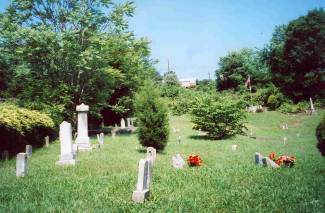Collection Name
About
CUMBERLAND – The Cumberland Historic Cemetery Organization is celebrating Black History Month by honoring the bygone souls and supporters of Sumner Cemetery, Allegany County’s first black graveyard.
The cemetery is located between Baltimore Avenue and Yale Street behind the Trinity Lutheran, St. Luke’s Lutheran and Greenmount cemeteries.
The once-neglected cemetery dates back to the 18th century, although many of the records, including burial information and grave markers, have been lost to history. It is estimated that 75 percent of the graves at Sumner are unmarked.
Numerous African-Americans and extended family members are buried at Sumner. It is also the location of six graves of black Union soldiers who were members of the United States Colored Troops during the Civil War.
Known as the 30th Regiment of the USCT, the unit was formed in February 1864. The soldiers fought in the Wilderness Campaign and saw action at Petersburg, Virginia. The six members buried at Sumner include Frank Taylor, Abraham Craig, Thomas Lindsey, Thomas Simpson, David Kinner and Sam Parry.
By the 1980s, the graves of the union soldiers, like many in Sumner Cemetery, were buried under feet of brush, vines and shrubs.
Although local citizens attempted to maintain the cemetery at different times over the years, it fell into a state of neglect. Area residents, including Virginia Williams, Christine Trimble, Bob Lytle and John Cooper, all now deceased, helped to maintain the cemetery.
Jacqueline Cooper and Susan Jones of Cumberland are currently involved in the effort to maintain it.
Jones said records are few but some facts are known.
She said the cemetery was named after Charles Sumner in March 1864 when the property was deeded to the black community of Allegany County with the officers listed as William H. Campbell, George Jackson and Peter Fagan, who were called the Sons of Sumner Cemetery. The men helped maintain the cemetery and were later buried there, according to Jones.
Cooper said it is important to take care of the cemetery.
“It reflects on our past,” said Cooper. “My ancestors are here. If they had not been through everything and enduring what they did, I would not be here today. I want to continue that and I have perpetuated that thought within my family so the dream lives on.”
The cemetery received a boost in 1990 when it was adopted by the Cumberland Historic Cemetery Organization.
Established in 1983, the group has adopted numerous cemeteries and have funded cleanups, as well as plaques and monuments, for many of the sites.
“In 1990, Virginia Williams contacted me about Sumner and asked about us getting involved in restoring it,” said Edward Taylor Jr., the group’s president. “We went there and when I saw it, the whole cemetery was literally covered with growth. My jaw about dropped to the floor. I wasn’t going to take it. It was just too much to take on.”
Taylor said CHCO staff convinced him restoring the cemetery was the right thing to do.
Sumner Cemetery contains little flat terrain; most is situated on a hillside. The majority of the graves, some of them containing multiple family members, are not marked. Often, a depression in the ground is all that exists.
“If everyone there had a tombstone that hill would be covered,” Taylor said. “We organized several cleanups. We had volunteers from AME Metropolitan, McKendree United Methodist, Ebenezer Baptist and kids from the boys forestry camps, but we were getting nowhere. We didn’t make headway; it was thick growth with terrible thorns clear to the top of the hills. We had to get gasoline and burn the growth. It was unreal.”
Cooper helped to clear the cemetery.
“We came out here, Ed and all of us, on our hands and knees,” she said. “We were unveiling tombs, rolling up stones, painting the benches, it was a labor of love but it was hard work.”
Taylor said they were able to identify several unmarked graves, including the grave of Critty Powell, a freed slave.
Cooper said it was Christine Trimble who helped find the Union soldiers’ graves, which were under several feet of growth high on the hill.
The CHCO funded monuments for the gravesites of the six solders, which were erected in 1991. Taylor said the monuments are the first in Maryland for any black Civil War soldier.
Still, many graves remained unmarked. Others buried at Sumner include Private Fulton J. Myers, who died in 1918, and Cooper’s great grandfather, Maj. Thomas Lee Sr.
Lee, a boxer, was a well-known porter at the Fort Cumberland Hotel. He was killed in a semifinal boxing match in Wheeling, West Virginia, by John Holmes, also of Cumberland.
“They brought him back here to be buried,” Cooper said. “My grandmother said he was buried on the knoll. We have searched high and low. We would love to put a marker on his grave.”
The cemetery was placed on the National Register of Historic Places in 1977. Currently, the Metropolitan AME and McKendree United Methodist churches own the land and provide upkeep.
“I want my children and the young children and adults in the community to know that there is something here for them and it represents them,” said Jones.
The CHCO holds an annual service at the site of the Union soldiers’ graves on the Sunday of Memorial Day weekend at 2 p.m. The public is welcome to attend.
For more info on the Cumberland Historic Cemetery Organization and Sumner Cemetery, visit www.chco.info.
